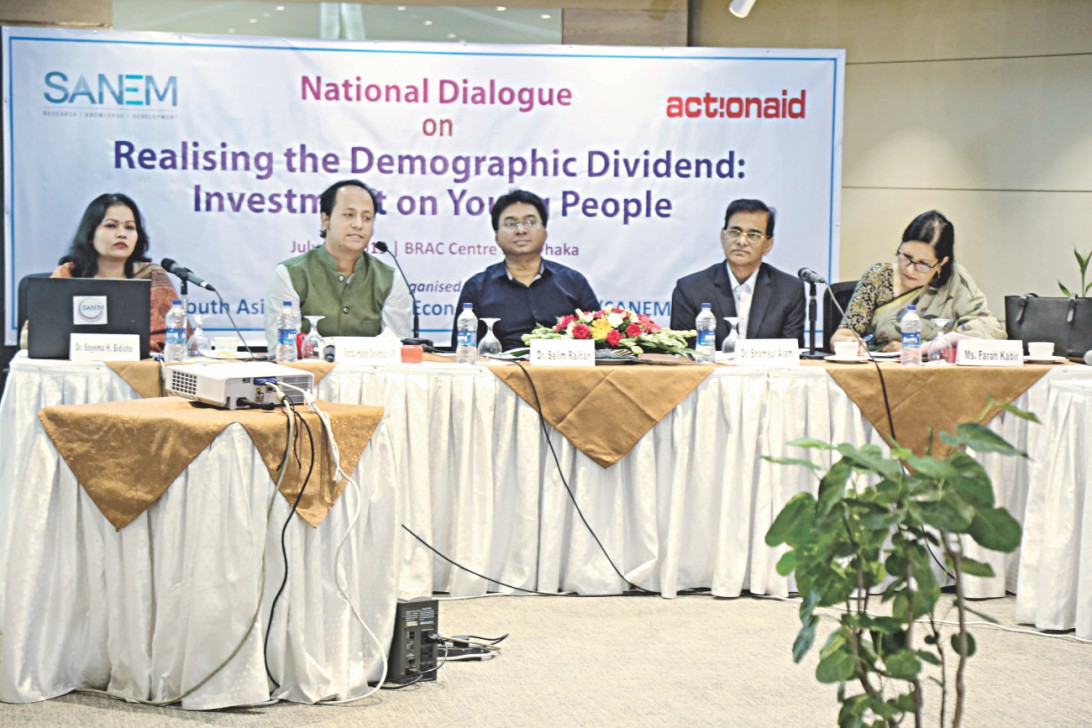Invest in youth to exploit demographic dividend

Bangladesh will have to invest more in its young people if it wants to make the most of the demographic dividend, speakers said yesterday.
Prof Shamsul Alam, member of General Economics Division of the planning commission, said Bangladesh would be able to reap the benefit of demographic dividend till 2040.
“So, it is high time to utilise the opportunity.”
He spoke at a seminar on “Realising the demographic dividend: investment on young people” organised by the South Asian Network on Economic Modeling (Sanem) at Brac Centre Inn at Mohakhali in Dhaka.
Mohibul Hassan Chowdhoury, deputy minister for education, said the country has not been able to get the demographic dividend yet.
He emphasised on developing skills of rural youth along with those in urban areas.
Prof Alam said the main target of the Eighth Five Year Plan would be to ensure the utilisation of the demographic dividend through creating jobs and tackling the fourth industrial revolution and it would be an action-based plan.
He termed the next development plan as the launchpad for Bangladesh’s goal of becoming a developed nation by 2041. The plan will also focus on creating quality workforce. “I will emphasise on applied fields in the Eighth Five Year Plan to utilise the demographic benefit,” he said.
Prof Alam underscored the need for research at tertiary level and urged both private and public universities to invest more in research to enhance skill.
For job creation, the private sector needs to come forward, for they account for 77 percent of the investment in the country, he said.
Farah Kabir, country director of ActionAid Bangladesh, said the government would have to play its role to make the most of the demographic dividend.
In her presentation, Sayema Haque Bidisha, research director of Sanem, focused on the fact that demographic dividend mainly depends on the quality of the working age population. “The quality of the population in turn depends on education, health and employment opportunities.”
She said as the demographic dividend would come to an end by 2040, the window of opportunity for reaping the benefit was very narrow.
A worrisome aspect for Bangladesh is that the youth unemployment rate is 10.6 percent and the youth not in education, employment and training (NEET) is 29.8 percent, according to the research director.
“This means that there is a massive challenge in utilising the demographic dividend.”
Bidisha said by 2030, private investment should be 30 percent of the country’s gross domestic product (GDP) in order to maintain a 9 percent GDP growth rate.
Selim Raihan, executive director of Sanem, said Bangladesh would become an upper middle-income country by 2031. “And there are tough times ahead for Bangladesh. In order to achieve the goal, private investment will have to be increased significantly.”
The economist also said the budgetary allocation for the health and education sectors should respectively go up to become 4 to 5 percent of the GDP by 2030.
Prof Moinul Islam, chairman of the population sciences department of the University of Dhaka, Mohammad Mohidul Islam, a joint director of Bangladesh Bank, and Nimmi Nusrat Hamid, policy research consultant of Brac, also spoke.
